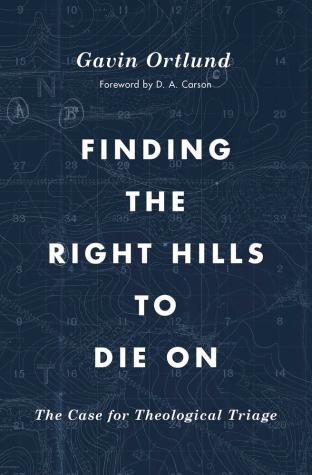To get right to the point, Choosing the Right Hill to Die On: The Case for Theological Triage is all about … theological triage. A redundant summarization perhaps, but the title (not the subtitle) could lead one to believe this is a volume on military strategy. The book is written by Gavin Ortlund, PhD. Ortlund serves as senior pastor of First Baptist Church of Ojai in Ojai, Ca. The book is published by Crossway in conjunction with The Gospel Coalition (TGC).
For those unfamiliar with the term theological triage, in its most basic meaning, it is the proposition that all doctrines are not of equal importance. The term “triage” is borrowed heavily from the medical community. In a medical triage emergency personnel make a determination of which injury/illness is most critical and must be treated first. It is the process of prioritization. With the addition of the term “theological” it becomes the prioritization of religious doctrine. The term was supposedly appropriated and hauled into the theology community by Albert Mohler of SBC fame.
Theological triage uses as its justification the unity of the church, the major point of emphasis in Ortlund’s argument. In brief the reasoning says that what’s really important is the gospel and by splitting hairs over doctrines that do not directly affect the gospel, the church is fractured. Only those doctrines that pertain to the gospel are vital. That’s what is critical, so let’s stick to those.
Regrettably, two critical terms are never specifically defined in the book: gospel and doctrine. Most crucial is the word gospel which is tossed around in today’s evangelical world to mean everything from Christ’s sacrifice on the cross to shoveling your elderly neighbor’s driveway in a snowstorm. No specificity is given.
Unfortunately, the reasoning that the unity of the church is at stake seems a bit ironic despite Ortlund’s plea. Those claiming the magnitude of theological triage cannot come to unity on the number of “ranks” or “tiers” for doctrines. Some claim there are three tiers, others (such as Ortlund) prefer a four-tier approach. And then there is the question of which doctrines fit into which tiers. Ortlund spends the majority of the book looking at three tiers – Primary, Secondary and Tertiary – and discussing a couple of doctrines that “fit” into each category. For instance, the Millennium and the makeup of the Creation Days are tertiary doctrines.
While theological triage may seem like a reasonable and passive solution to the lack of unity in the church, two major questions arise. First, as discussed above, what doctrines are to be selected as “first-tier” and second and so on. Second, and quite crucial, who gets to select those doctrines? Does the SBC, TGC, Al Mohler, Gavin Ortlund, some ivory tower scholar, each individual church? Who?
The context of the book is quite suitable. Ortlund presents his case in a logical although brief manner. (The Case for Theological Triage is just 152 pages.) Unfortunately, the case is weak. However, if you are unfamiliar with theological triage and desire a fast tutelage, this would be a good introductory but not final volume to read. There is no doubt that Ortlund’s intentions are in the right place. It just seems that a defense of theological triage is the wrong hill to die on.
Disclaimer: The book was provided to me by Crossway for a fair and honest review.

